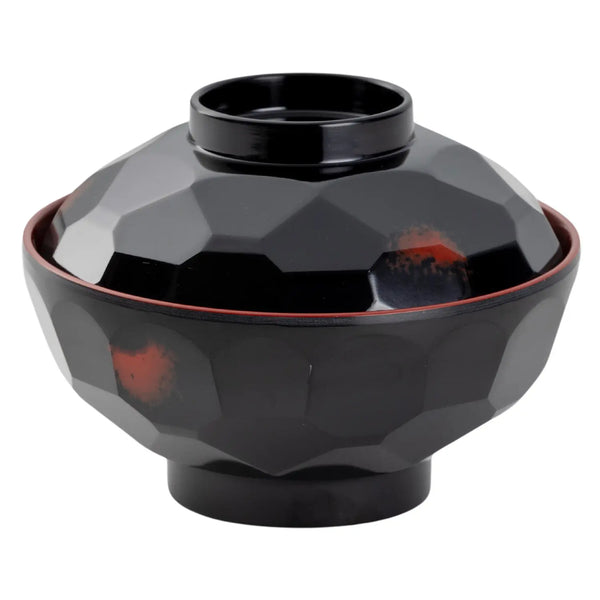The product we used:
Miso Soup: An Easy and Versatile Japanese Food

If you want to learn how to cook Japanese food, but aren't sure where to start, you can't go wrong with learning how to make miso soup. It's a good food to learn as a beginner for a couple of reasons. First, it's easy to make. For an American, the hardest part of making miso soup will be finding the ingredients. Otherwise, it's mostly just cutting and boiling, which is one step more than it takes to make a bowl of pasta (my specialty). The second reason it's a great food for beginners is its versatility. There are different kinds of dashi (soup stocks), miso paste, and ingredients that you can use to make miso soup, so in addition to being easy to make, there are many delicious flavor combinations to explore. Dashi used in miso soup are themselves very versatile, being the foundation of many other Japanese dishes. Miso soup, along with white rice, is served with practically every Japanese food. Once you feel confident in your miso soup making skills, you can apply them with many of the Japanese meals you prepare in the future.
And if you got a ENTEC Melamine Kikko-Pattern Soup Bowl for Christmas, then you have the perfect bowl for serving miso soup, wink wink knudge knudge.
In this article, first I'll provide a recipe for the classic tofu and wakame miso soup people in Japan enjoy year-round. Afterward, I'll explain the principles behind making other kinds of miso soup and deepening your skill with this classic Japanese food.
Simple Tofu and Wakame Miso Soup
Ingredients:
- 4 cups dashi stock (vegetable or bonito-based)
- 3 tablespoons white miso paste
- 1 cup silken or fried tofu, cubed
- 1/4 cup wakame seaweed, rehydrated and chopped
- 2 green onions, sliced
- 1 tablespoon soy sauce (optional, for additional flavor)
Instructions:
Prepare Dashi Stock

If you don't have store-bought dashi stock, you can make it by simmering kombu (dried kelp) in water and then adding bonito flakes. Strain the liquid to obtain dashi stock.
Rehydrate Wakame and Cook with Tofu

Soak the wakame seaweed in warm water for about 5 minutes or until it's soft. Drain and chop it into bite-sized pieces.
In a pot, add the dashi stock and bring it to a simmer over medium heat. Add the cubed silken tofu or cut fried tofu. Add the rehydrated and chopped wakame seaweed to the soup. Cook for 3-4 minutes.
Dissolve Miso Paste

In a small bowl, dissolve the white miso paste in a ladle of the hot dashi stock. Make sure there are no lumps.
Add Miso to Soup

Add the dissolved miso paste to the pot and stir well to combine. Be careful not to boil the soup after adding miso, as high heat can affect its flavor.
Season the Soup
Optionally, add soy sauce to the soup for additional flavor. Taste and adjust the seasoning as needed.
Serve

Ladle the simple tofu and wakame miso soup into bowls. Garnish with sliced green onions.
The First Principles of Making Miso Soup
Miso soup has three basic layers:
- Dashi (soup stock)
- Ingredients
- Miso
To get started, let's talk about the dashi.
Dashi
Dashi is soup stock, typically vegetable or fish-based. Miso soup derives its savory flavor from all of the ingredients, not just the dashi. That means that you can use dashi with a simple, light flavor. We recommend getting started by using a pre-made dashi. Pre-made dashi is easy to find online. You can find dashi that's primarily vegetable-based, fish-based, or some combination of the two. If you buy dry dashi, it should include instructions for mixing it with water.
However, if you're feeling adventurous, you can make your own seaweed-based dashi easily.
Ingredients:
- 1 piece of dried kombu (about 4-6 inches in length)
- 4 cups cold water
Instructions:
Clean the Kombu
Gently wipe the kombu with a damp cloth to remove any excess salt or impurities. Avoid washing it under running water to preserve its natural flavor.
Soak the Kombu
Place the kombu in a large pot or a bowl and add 4 cups of cold water. Allow it to soak for at least 30 minutes. Some recipes recommend soaking for several hours or overnight for a more intense flavor.
Infuse the Dashi
Place the pot with the kombu and water over medium heat. Slowly bring it to just below a simmer, as high heat can make the kombu release a bitter taste. Be attentive and remove the kombu just before the water starts to boil.
Remove Kombu
Once the water is hot and small bubbles start to form around the edges (but before it boils), remove the kombu from the pot. Boiling kombu can result in a slimy texture and an undesirable flavor.
Strain the Dashi
If you want a clear dashi, strain the liquid through a fine-mesh sieve or cheesecloth to remove any small particles.
Use or Store
Your kombu dashi is now ready to use in various recipes, including miso soup, noodle broths, or as a base for other Japanese dishes. Alternatively, you can store it in the refrigerator for a few days or freeze it for longer storage.
Again, preparing dashi this way is optional. We recommend preparing your own homemade dashi this way after you're comfortable making miso soup with a pre-made dashi.
Ingredients
The basic principle behind miso soup is to combine different flavors, textures, and colors. A good rule-of-thumb is to combine bite-sized cubes of tofu with some seasonal vegetables. Here are some common seasonal combinations.
- Spring: Takenoko (Bamboo Shoots) and Mitsuba (Japanese Parsley)
- Summer: Suuji (Sliced Okra) and Myoga (Japanese Ginger)
- Fall: Kabocha (Japanese Pumpkin) and Ginnan (Ginkgo Nuts)
- Winter: Furofuki Daikon (Simmered Daikon Radish) and Hakusai (Napa Cabbage)
For certain leafy vegetables (like spinach), you should consider parboiling them first before adding them to the dashi. Greens can be a bit astringent. Parboiling removes that astringency. For root vegetables, like daikon (radish) or renkon (lotus root), parboiling usually isn't necessary.
Some vegetables, like shiitake, are going to add quite a bit of flavor of their own to the soup. In such cases, cooking with a light-flavored dashi will allow those other flavors to shine through.
However, for beginners, we recommend preparing your first miso soup with the classic year-round combination: tofu and wakame (recipe above). Again, it's versatile and easy to cook, perfect for beginners.
Miso

For miso, the most common kinds are red (aka, 赤) miso and white (shiro, 白) miso. Each one has a different flavor profile and combines well with different dashi and ingredients. Speaking of combining, it's common to combine both kinds of miso when making miso soup. In fact, red miso alone is often considered too astringent by itself, so restaurants in Japan typically mix a bit of white miso with red miso. For this article, my wife made miso soup that mixed both. White miso has a lighter flavor and red miso has a deeper flavor.
I have never gone miso shopping in the US, but a quick search on Amazon shows that white miso appears to be more popular than red miso, but it's not hard to find red miso, either. I'd start with white miso to get yourself used to the flavor, and then once you're confident with your miso cooking abilities, try red miso with different dashi and ingredients.
It's common to cook with red miso in the summer and white miso in the winter.
Tips for Beginners
- A good starting miso-to-dashi ratio would be 2 1/2 tablespoons of miso for every 500ml (about 1 3/4 cups) of dashi.
- Once you add miso to the dashi, don't boil it.
- Start with a pre-made dashi and then later try making a homemade dashi.
- If you make homemade kombu-based dashi, don't boil the kombu.
- When you are comfortable making a simple tofu and wakame miso soup, try exploring different seasonal vegetables for use in miso soup.





